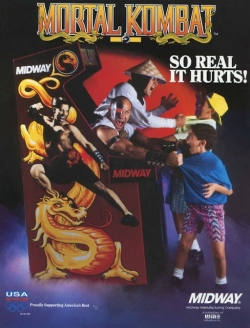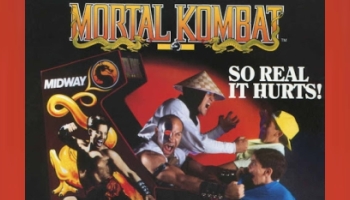 Ed Boon has nurtured the soul of the Mortal Kombat franchise for more than 30 years now. Development began in 1991 when Boon, alongside co-creator John Tobias, pitched a fighting game starring Jean-Claude Van Damme to their bosses at Midway. That part of the plan quickly fizzled out, but the decisionmakers at the company were still interested in creating an original fighting game to piggyback on the success of Street Fighter II.
Ed Boon has nurtured the soul of the Mortal Kombat franchise for more than 30 years now. Development began in 1991 when Boon, alongside co-creator John Tobias, pitched a fighting game starring Jean-Claude Van Damme to their bosses at Midway. That part of the plan quickly fizzled out, but the decisionmakers at the company were still interested in creating an original fighting game to piggyback on the success of Street Fighter II.
A year later, Boon and Tobias (and John Vogel and Dan Forden) were ready to deliver the first cabinets for Mortal Kombat to arcade operators on October 8, 1992. Pre-release reactions to the game, both within Midway and from the public, were trending in the right direction, but the team had no idea just how much of an impact their creation would soon have on the game industry… and the entire world.
To celebrate the fighting franchise’s 30th anniversary, Boon and Tobias have been sharing stories from Mortal Kombat‘s development over the last year on Twitter. Let’s take a look at a few of them.
![]() You can find a lot of dedicated video game historians on Twitter, and in 280 characters or less, they always manage to unearth some amazing artifacts. Bite-Sized Game History aims to collect some of the best stuff I find on the social media platform.
You can find a lot of dedicated video game historians on Twitter, and in 280 characters or less, they always manage to unearth some amazing artifacts. Bite-Sized Game History aims to collect some of the best stuff I find on the social media platform.
For many players, their first exposure to Mortal Kombat was through its famous dragon medallion, which sat at the very top of the arcade cabinet’s side panel (though many operators hid the game behind a black curtain to “protect” the public from its bloody violence). Mortal Kombat‘s iconic logo has remained mostly unchanged ever since, but interestingly, it was one of the last pieces of art designed by Tobias.
The medallion’s design is based on a dragon statue that actually sat on the desk of Midway’s General Manager, Ken Fedesna, and it was digitized and initially included as a background element in Shang Tsung’s throne room. This small hunk of metal must have struck a chord with the team, because around the same time the game was known as “Dragon Attack” (inspired by the Queen song of the same name) before Boon and Tobias settled on Mortal Kombat.
Starting with the original pencil sketch used to digitize the dragon medallion, this thread from Tobias also unearths an early “Dragon Attack” marquee, another version of the logo inspired by the yin yang symbol, and much more:
Here’s a recently discovered image of the very first drawing of #MortalKombat’s dragon icon. I designed the icon as both a symbol of our game and its fictional tournament… (thread) #MK30 pic.twitter.com/vVIDr4K9aP
— John Tobias (@therealsaibot) September 22, 2022
While the dragon medallion served as the symbol for Mortal Kombat, and Liu Kang was the game’s main character, the ninjas Scorpion and Sub-Zero quickly became the face of the franchise for many players.
The palette-swapped fighters may have always looked alike, but Boon and Tobias gave each one their own personality with unique stances and special moves, as you can see in this behind-the-scenes footage recorded by Boon with actor and martial artist Daniel Pesina:
Continuing our celebration of Mortal Kombat's 30th anniversary, here's another video showing more behind-the-scenes moments. This time you can see how we decided to give Scorpion & Sub-zero different fight stances so they would look & feel like two separate characters. pic.twitter.com/t8fJmYexcu
— Ed Boon (@noobde) March 10, 2022
The developers at Midway have always been open about their admiration for Big Trouble in Little China, and Mortal Kombat would probably look very different if John Carpenter’s wild action flick didn’t exist. You can definitely see this influence in Shang Tsung, who owes more than a bit of a debt to ancient sorcerer David Lo Pan. And you can also see it in Raiden, who borrowed his signature straw hat from the film’s other supernatural antagonists, The Storms.
According to John Tobias, the hat gave Raiden a “distinctive silhouette,” but it also made the process of recording his moves quite difficult, as you can see in this behind-the-scenes video from Boon. Carlos Pesina portrayed the character in the first game, and while the hat was often uncooperative, it did give the team the idea for the Elder God’s Teleport move:
Here is our 3rd video celebrating Mortal Kombat’s 30th anniversary! (More to come!) This is more of a fun video that features behind-the-scenes of us filming one of MK’s most recognizable characters. Raiden was played by a FANTASTIC martial artist and friend, Carlos Pesina. pic.twitter.com/IeBEAN6883
— Ed Boon (@noobde) May 4, 2022
Only six characters were available in Mortal Kombat for its first location test in April 1992, and the team quickly realized that a seventh was needed. Boon and Tobias batted a few ideas back and forth, including a new combatant named Stryker. But instead of the riot cop who would later appear in Mortal Kombat 3, this character would morph into Sonya Blade during these brainstorming sessions.
The developers knew exactly what they wanted to do with Sonya, but conveying her acrobatic moveset to her original performer, Elizabeth Malecki, proved tricky. But it was all worth it in the end, as Boon fulfilled his promise to Malecki and made Sonya’s Leg Grab look very cool:
Continuing with Mortal Kombat's 30th anniversary celebration. This video gives a peek into how Sonya Blade came to be, including her infamous LEG GRAB move. On April 10, 1992 we tested an unfinished version of MK (only 6 fighters) at a Chicago arcade called TIMES SQUARE. (1 of 9) pic.twitter.com/RSKHnnUCO2
— Ed Boon (@noobde) August 22, 2022
Let’s finish it with John Tobias, who shared some memories of his own from that location test at the the Times Square arcade in Chicago. Even though Mortal Kombat was missing Sonya, and the game itself was housed in a plain black cabinet, it drew a considerable reaction from the weekend crowd. Curious onlookers flocked to the game and their was a feeling among the team that they had something special on their hands.
At the end of the night, Tobias took a moment to rescue one of the first tokens deposited in the game for luck. Perhaps the team never needed luck, but Tobias kept that coin all these years, and we’re still all talking about Mortal Kombat:
30yrs ago today, @noobde and I watched the first players ever to play Mortal Kombat drop tokens into our game at Times Square Arcade on Clark and Broadway in Chicago…
This is one of those tokens. Pulled from the coin box for good luck… #MK30 (1/5) pic.twitter.com/hZXzTtUjEz
— John Tobias (@therealsaibot) April 10, 2022
Thank you to Ed Boon and John Tobias for giving us this small glimpse into the development of Mortal Kombat. And in case you missed it, I previously wrote about one of Boon’s earlier videos that went into the creation of Scorpion’s Spear. It’s definitely worth a rewatch on such a momentous anniversary.

